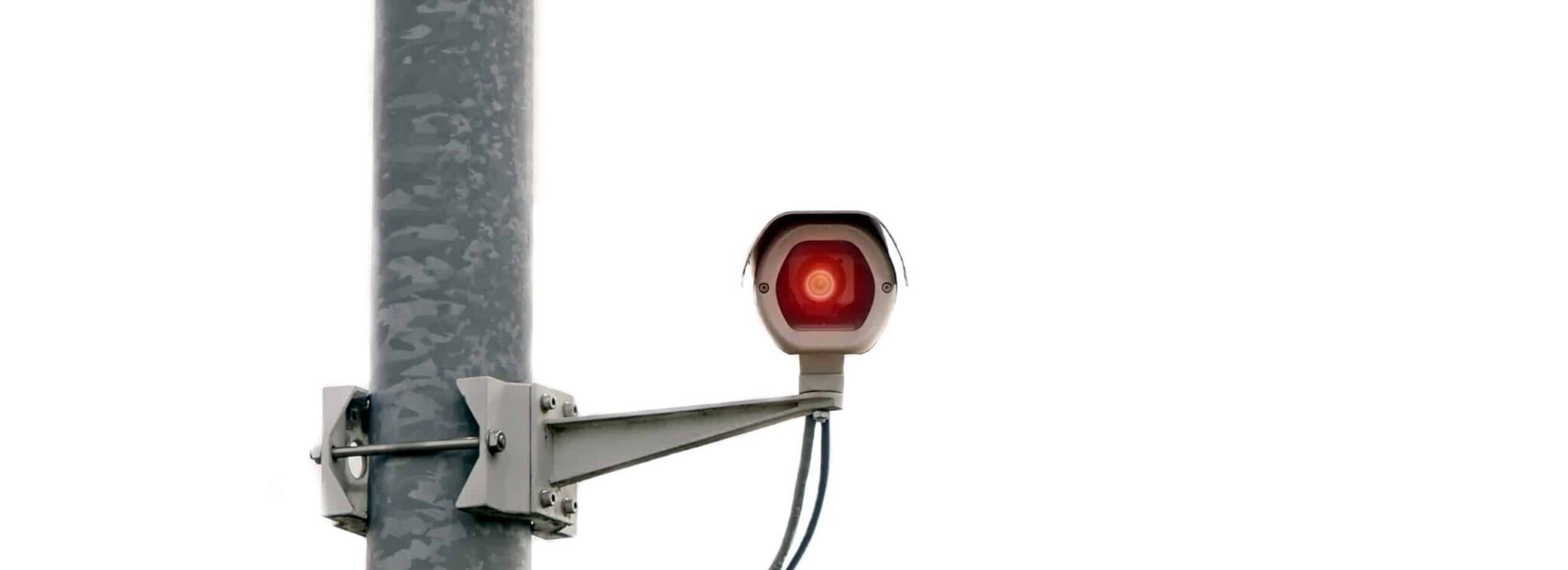When George Orwell published the dystopian novel Nineteen Eighty-Four in 1949, who knew that it would describe video surveillance through devices like two-way telescreens or two-way televisions that we would see something like that today?
In the story, the residents of Oceania had no privacy. Many lived in apartments with two telescreens that the government could see and hear through at any time. Video surveillance today is not as invasive as it was for the people of Oceania.
Instead, people accept there are video cameras everywhere. No longer is it limited to banks and ATM machines. Video surveillance has reached the point of affordability that many homeowners use it for doorbells and companies gain eyes on their property around-the-clock.
Thinking about the book prompts the question on the history of remote video surveillance for businesses. When did it begin and how did it evolve?
The Late 1800s: First Motion Picture Cameras
The beginning of video surveillance starts with the development of the movie camera in 1870. Wordsworth Donisthorpe, an English barrister and inventor, patented the moving picture camera that he called kinesigraph. He jointly filed the patent with his cousin William Crofts.
The patent covered a device to take a series of pictures at set intervals to capture the movement of what appears in the photographs. Donisthorpe suggested that combining his kinesigraph with Thomas Edison’s phonograph could capture a talking picture.
Elsewhere in 1877, Eadweard Muybridge used his zoopraxiscope, a device to project motion pictures, with multiple cameras to film motion and stop-motion photos. He produced more than 100,000 images of movement.
Donisthorpe patented a film camera and projector in 1889 when Frenchman Louis Le Prince lived in Donisthorpe’s home. Building on Muybridge’s work, Le Prince patented a 16-lensed camera that moved the video camera forward, but it still needed work. After much experimenting, he invented and patented the first single-lensed motion picture in 1888. He used it to capture the first known motion picture on film.
Thomas Edison and his employee William Dickson created and patented the kinetophone and kinetograph respectively. At the 1893 World’s Fair in Chicago, Edison demonstrated the kinetoscope that allowed one person to peep into a large box to view moving images.
The first motion picture companies came to fruition before 1900. Surveillance video would not have become a reality without these inventors’ creations and experiments. They found a way to capture movement on film.
The 1940s: Earliest Known Uses of Closed-Circuit Television (CCTV)
A closed-circuit TV is a system of cameras used to transmit video signals to set monitors that are not publicly accessible. The first known CCTV appeared in 1942. Walter Dornberger’s V2, published in 1954, indicates Walter Bruch designed and oversaw the implementation of CCTV technology in Nazi Germany to monitor the launch of V-2 rockets.
A few years later in 1949, the first commercial CCTV called Vericon appeared in the U.S. according to Popular Science. It did not require a government permit to operate. At this point, CCTV wasn’t a feasible option for security because it required constantly watching monitors as recording didn’t become available until later.
The 1950s: First Video Tape Recorder and Growing CCTV Use
ThoughtCo.’s “The History of Video Records — Video Tape and Camera” states Charles Ginsburg developed one of the first videotape recorders in 1951. He led the research team at Ampex Corporation to design a recorder that captured live video from TV cameras.
The technology converted the video into electrical impulses and stored them on magnetic tape. The television industry adopted the technology by 1956. Recording didn’t become a widespread option because setting up the system and using it was labor intensive.
Already by 1957, CCTV found an education audience. Companies like General Precision Laboratories (GPL) worked with school districts to figure out a way to install CCTV for an affordable price to give students access to teachers with special skills and knowledge.
Although color cameras started appearing in the 1950s, they weren’t as effective for video surveillance as black and white cameras. Black and white cameras provided higher resolution and clearer views in low light.
The 1970s: Video Cassettes and Charge-Coupled Device
Sony sold the first commercially available video cassette recorders (VCRs) in 1971. The VCR eventually paired with CCTV allowed users to record remote surveillance for later viewing. While this improved video surveillance, businesses still faced the problem of storage capacity. Some businesses would use one cassette per day of the week.
Video surveillance and recording gained momentum as a security measure in the 1970s and 1980s. Banks and retailers installed CCTV with VCRs to prevent theft.
The charge-coupled device (CCD) enters the picture in 1976. Using microchip technology, it made it possible to create cameras with more pixels to produce higher quality images in low-light situations and provide 24/7 video surveillance. CCD costs more than complementary metal–oxide–semiconductor (CMOS), but it captured images more effectively in low light conditions at a higher quality than CMOS.
The 1990s: Arrival of First IP Cameras and DVRs
Remote video surveillance soared in 1996 when Axis introduced the first network-attached IP video security cameras. Using the ethernet network, IP cameras could send video signals as digital encoded signals instead of analog. However, IP acceptance grew slowly because analogy security dealers didn’t grasp the concept early on.
The advent of computers in the 1980s and 1990s brought about a rise in computer dealers. It was these professionals who first sold IP camera systems. They understood computers and networking, which helped them see IP’s potential. That jump-started CCTV’s decline.
It was also during the ’90s when digital video recorders came into existence. They contained hard disc drives to capture recorded video, eliminating the need for tapes. These could store large amounts of digital video.
The 2000s: The Rise of the IP Cameras in Video Surveillance
Although SecurityInfoWatch.com reports the first IP camera from Axis Communications was underwhelming, it didn’t take long before IP cameras surpassed CCTV. The full frame network IP camera appeared in 2000 in Common Intermediate Format (CIF). A short three years later, it reached 4CIF, offering a higher resolution and scanning technology.
The resolutions on IP cameras improved quickly. Initially, they provided video resolution that was VGA (640 x 480), comparable to the older analog cameras. IQinvision introduced the first megapixel IP cameras in 2002. This provided more than four times the resolution of the older VGA cameras.
Two years later, 2-megapixel cameras arrived for a massive improvement over analog technology. This was a huge leap forward for the industry. Still, megapixels lagged in frame and light sensitivity.
The megapixel IP cameras started seeing improvements in light sensitivity by 2006. It was in this year that the industry saw a huge potential for analytics in remote video surveillance. Nonetheless, few had implemented it.
Another two years later, H.264 standard video compression format entered IP surveillance. This move propelled IP cameras because it increased resolution while keeping increases in total costs reasonable. The earlier MJPEG encoding format drove up costs that many passed on them on price alone.
By 2009, people could view IP cameras in HDTV. This offered the same image quality as standard TV sets. That was also the year IP video quality completely outshined analog in every way. They performed 600 times better than the first IP camera in 1996 known as Neteye.
The 2010s: New Video Surveillance Technology: Some Thrive, Some Flail
The P-iris lens debuts to provide precise control software in the camera. It overcame some of the lighting issues in high megapixel cameras and the frame rates climb up to 12 fps at 5 megapixels. Every camera contained HDTV, including dome and pan-tilt-zoom (PTZ).
As IP cameras improved in quality and affordability, the industry started having their head in the clouds, literally. They saw connecting IP cameras to the cloud as a way to eliminate on-site recording and on-site maintenance. However, bandwidth and video management software cloud capabilities prevented this from ever taking off.
Edge storage was hot in 2012 and then forgotten by 2014. The industry had hoped they’d eliminate network video recorders (NVRs). Reliability problems hurt their chances of taking off. During this period, IP cameras got better at handling harsh lighting conditions and darkness.
It was H.264 that changed everything for IP cameras. Smart CODECs could be the next evolution. These dynamically adapt compression to reduce bandwidth by 50 percent compared to what H.264 yields. If Smart CODECs gain acceptance, they could lower costs and remote networking problems.
Very high-resolution 4K cameras entered the market in 2015, but their specifications proved confusing. A typical 4K IP camera provides at least 4,000 horizontal pixels. And yet, there are multiple types of 4K cameras with each having different capabilities. For example, you can find 8-, 12-, or 20-megapixel cameras that are all 4K.
Why is this important? Because it can affect pricing. Low-priced 4K cameras most likely have subpar lenses. The highest resolution cameras come with better lenses. The lenses alone greatly influence the cost of the camera. The advantage of these high-performance cameras is that they can include longer-range IP cameras to view items further away and in darkness.
Remote Video Surveillance Today
The market floods with IP cameras, everything from affordable consumer-level grade cameras to high-grade professional video surveillance cameras. The professional security market uses ultra-high-resolution cameras with better low light range.
What’s the point of this stroll through video surveillance’s illustrious history? The biggest one is that technology constantly changes, and you never know what to bet on. Something that looks like a winner turns out to be a dud. Sometimes the better technology doesn’t always win. Experts agree Betamax provided better quality recordings than VHS, and yet VHS gained widespread acceptance while Beta faltered.
Moreover, businesses looking to invest in remote video surveillance have a multitude of options to consider. HD video, long-range surveillance, PTZ, time-lapse video, thermal imaging, and more. Implementing the right solution depends on the company’s needs. The type of video is only part of the equation. Companies still need to think about video review and analysis, system maintenance, and surveillance services.
Video surveillance has come a long way from what Orwell described in Nineteen Eighty-Four. Companies rely on video surveillance to enhance security, improve processes, and watch the business after hours. Unlike what the government did in Orwell’s book, businesses do not use it to keep people in line and to prevent rebellion.
They use it to protect their most valuable assets and keep employees safe. The complexity of the options compels many companies to work with a video surveillance vendor like Stealth Monitoring.
You can count on us to keep researching and studying the latest technology. You want options that deliver the biggest bang for the dollar. We have the knowledge and experience to do that for you and design a right-sized remote video surveillance system that meets your requirements. To learn more, please contact us.

